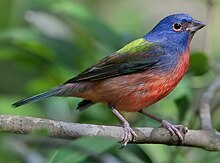Painted bunting
| Painted bunting | |
|---|---|
 |
|
| Male | |
| Scientific classification | |
| Kingdom: | Animalia |
| Phylum: | Chordata |
| Class: | Aves |
| Order: | Passeriformes |
| Family: | Cardinalidae |
| Genus: | Passerina |
| Species: | P. ciris |
| Binomial name | |
|
Passerina ciris (Linnaeus, 1758) |
|
 |
|
| Range of P. ciris Breeding range Wintering range | |
The painted bunting (Passerina ciris) is a species of bird in the cardinal family, Cardinalidae, that is native to North America. The bright plumage of the male only comes in the second year of life; in the first year they can only be distinguished from the female by close inspection.
The painted bunting was originally described by Carl Linnaeus in his eighteenth-century work Systema Naturae. There are two recognized subspecies of the painted bunting:
The male painted bunting is often described as the most beautiful bird in North America and as such has been nicknamed nonpareil, or "without equal". Its colors, dark blue head, green back, red rump, and underparts, make it extremely easy to identify, but it can still be difficult to spot since it often skulks in foliage even when it is singing. The plumage of female and juvenile painted buntings is green and yellow-green, serving as camouflage. Once seen, the adult female is still distinctive, since it is a brighter, truer green than other similar songbirds. Adult painted buntings can measure 12–14 cm (4.7–5.5 in) in length, span 21–23 cm (8.3–9.1 in) across the wings and weigh 13–19 g (0.46–0.67 oz).
The juveniles have two inserted moults in their first autumn, each yielding plumage like an adult females. The first starts a few days after fledging replacing the juvenile plumage with an auxiliary formative plumage; the second a month or so later giving the formative plumage.
The painted bunting occupies typical habitat for a member of its family. It is found in thickets, woodland edges with riparian thickets, shrubbery and brushy areas. In the east, the species breeds in maritime hammocks and scrub communities. Today, it is often found along roadsides and in suburban areas, and in gardens with dense, shrubby vegetation. The wintering habitat is typically the shrubby edges along the border of tropical forests or densely vegetated savanna. The breeding range is divided into two geographically separate areas. These include southern Arizona, southern New Mexico, southern and eastern Texas, Oklahoma, Arkansas, Louisiana, northern Florida, coastal Georgia, the southern coast and inland waterways such as the Santee River of South Carolina and northern Mexico. They winter in South Florida, Cuba, the Bahamas, along both coasts of Mexico and through much of Central America. Occasionally, they may be vagrants further north, including to New YorkPennsylvania and New Jersey. The bird is also found every few years as far north as New Brunswick, Canada.
...
Wikipedia

